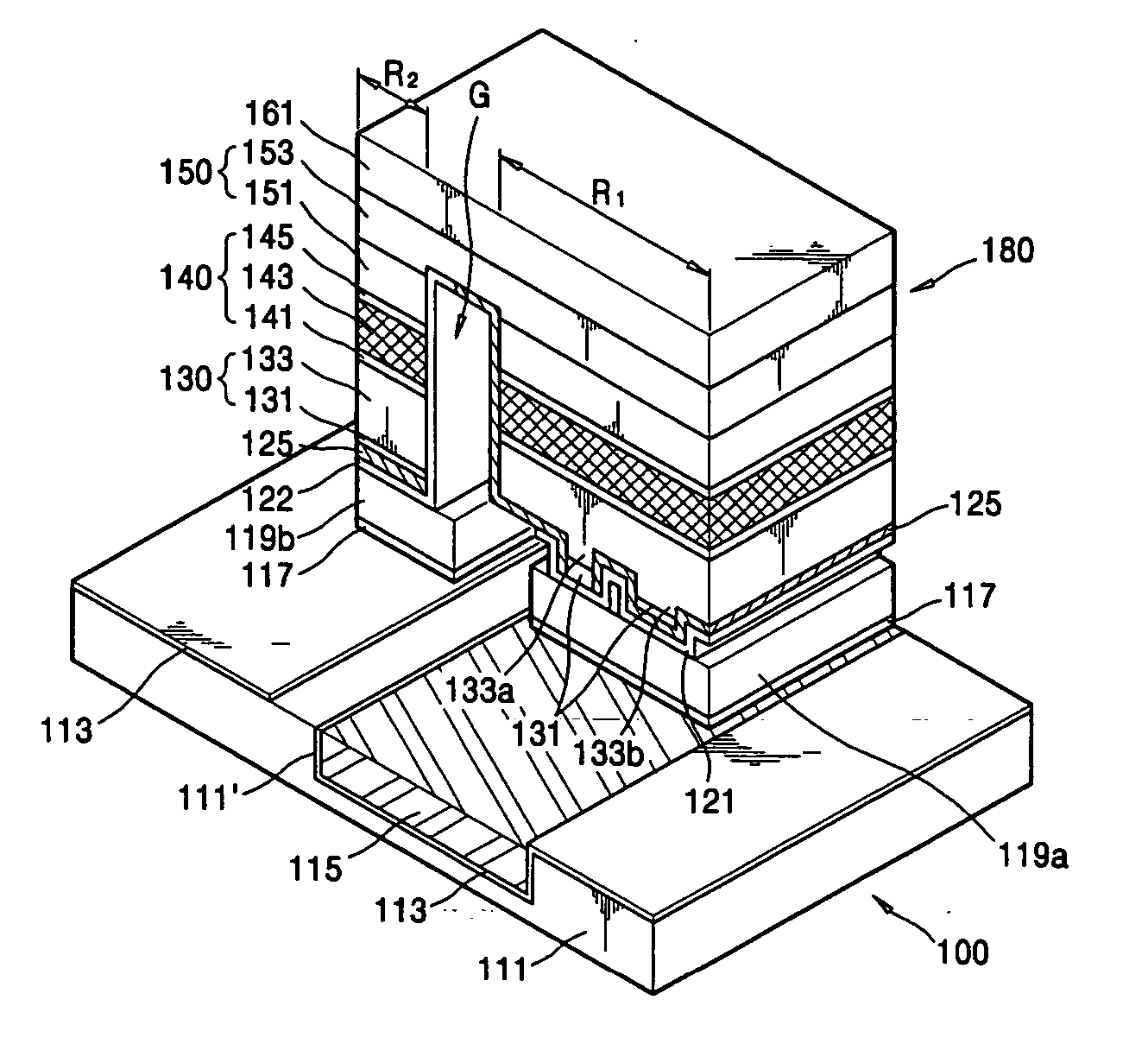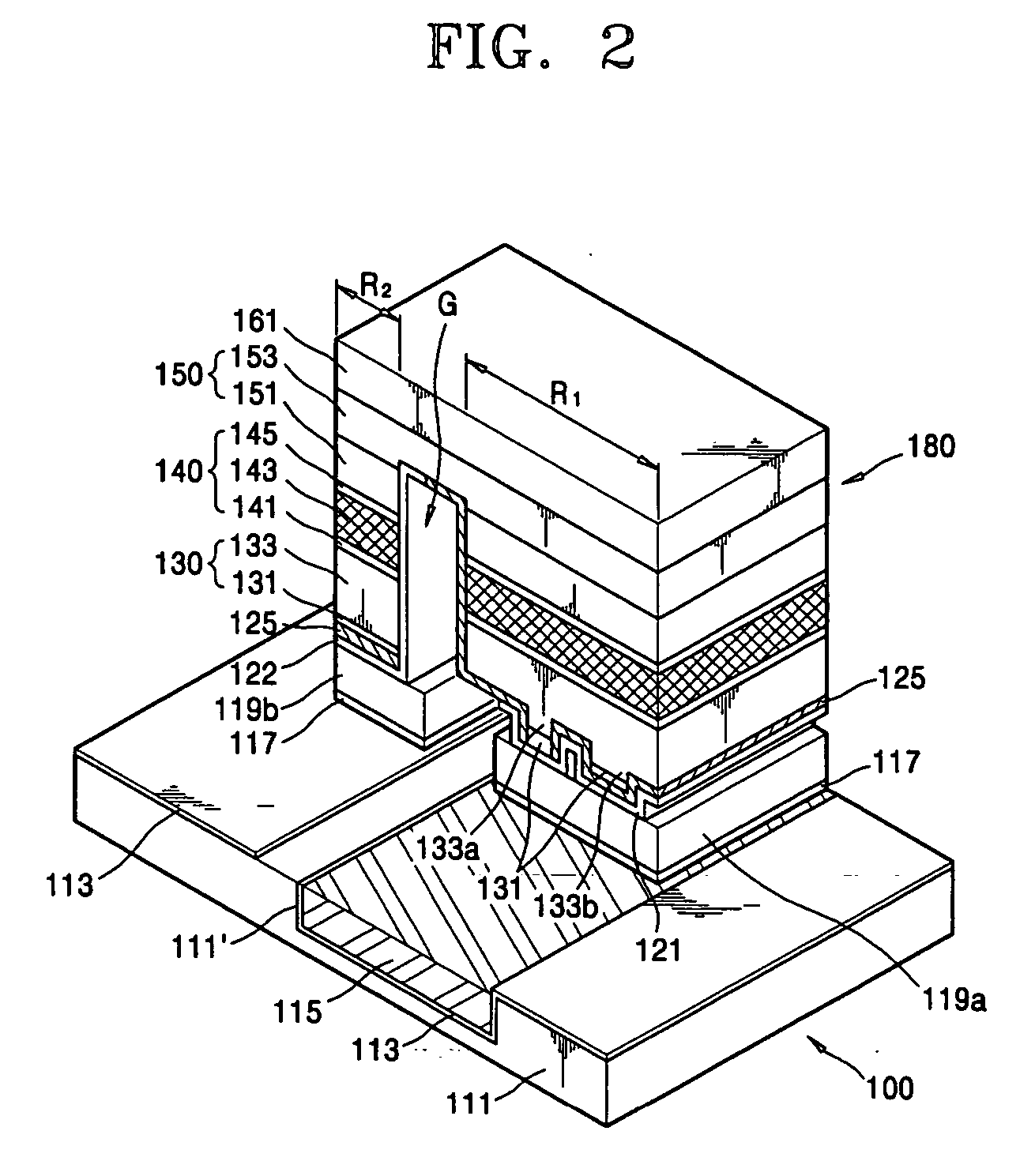Heat dissipating structure and light emitting device having the same
a heat dissipating structure and light-emitting technology, applied in semiconductor lasers, semiconductor/solid-state device details, lasers, etc., can solve the problems of reducing the output power of high-output laser diodes with high injection current, difficult to effectively dissipate heat, and affecting so as to prevent the degradation of light-emitting elements and improve the efficiency of heat dissipation. , the effect o
- Summary
- Abstract
- Description
- Claims
- Application Information
AI Technical Summary
Benefits of technology
Problems solved by technology
Method used
Image
Examples
first embodiment
[0026] The present invention will now be described more fully with reference to the accompanying drawings, in which exemplary embodiments of the invention are shown. Referring to FIG. 2, a light-emitting device according to the present disclosure includes a light-emitting element 180 and a heat dissipating structure 100 that are flip-chip bonded to vertically face each other. The light-emitting element 180 includes a substrate 161 forming a base, and an upper material layer 150, a resonant layer 140 and a lower material layer 130 sequentially formed beneath the substrate 161. Here, the structure of the layers formed beneath the substrate 161 is divided into a first area R1 and a second area R2 separated from the first area R1 by a gap G.
[0027] The substrate 161 may be formed of sapphire or III-V compound semiconductor such as gallium nitride (GaN) or silicon carbide (SiC). The upper material layer 150 is formed beneath the substrate 161 and includes a first compound semiconductor la...
second embodiment
[0042]FIG. 4 is a perspective view of a light-emitting device according to the present disclosure. Referring to FIG. 4, like the light-emitting device of FIG. 2, the light-emitting device includes a light-emitting element 280 and a heat dissipating structure 200 flip-chip bonded to the light-emitting element 280. The light-emitting element 280 includes a substrate 261, and an upper material layer 250, a resonant layer 240 and a lower material layer 230 sequentially formed beneath the substrate 261 at first area R1. The upper material layer 250 has a stepped structure that extends to a second area R2. The resonant layer 240 allows laser light to oscillate due to light energy created by recombination of carriers and the upper and lower material layers 250 and 230 are electrically connected to n- and p-type electrodes 222 and 221, respectively. The p-type electrode 221 is formed in the lowermost portion of the first area R1 and coupled to the lower material layer 230 exposed by a curre...
third embodiment
[0047]FIG. 5 is a perspective view of a light-emitting device according to the present disclosure. Like reference numerals in FIGS. 2 and 5 denote like elements. Referring to FIG. 5, a submount 311 has a first groove 311′a formed along one direction and a plurality of second grooves 311′b arranged perpendicular to the length of the first groove 311′a. The first and second grooves 311′a and 311′b are filled with a conductive material layer 315 that rapidly diffuses heat along the plane of the submount 311. The conductive material layers 315 are formed in the two orthogonal directions to facilitate two-dimensional heat diffusion. The heat transferred to the submount 311 is dissipated by natural convection through the outer surface of the submount 311. In this case, heat uniformly transferred to the entire outer surface of the submount 311 is efficiently dissipated through a wide heat transfer area. A metal medium layer 313 may be formed between the conductive material layer 315 and th...
PUM
 Login to View More
Login to View More Abstract
Description
Claims
Application Information
 Login to View More
Login to View More - R&D
- Intellectual Property
- Life Sciences
- Materials
- Tech Scout
- Unparalleled Data Quality
- Higher Quality Content
- 60% Fewer Hallucinations
Browse by: Latest US Patents, China's latest patents, Technical Efficacy Thesaurus, Application Domain, Technology Topic, Popular Technical Reports.
© 2025 PatSnap. All rights reserved.Legal|Privacy policy|Modern Slavery Act Transparency Statement|Sitemap|About US| Contact US: help@patsnap.com



